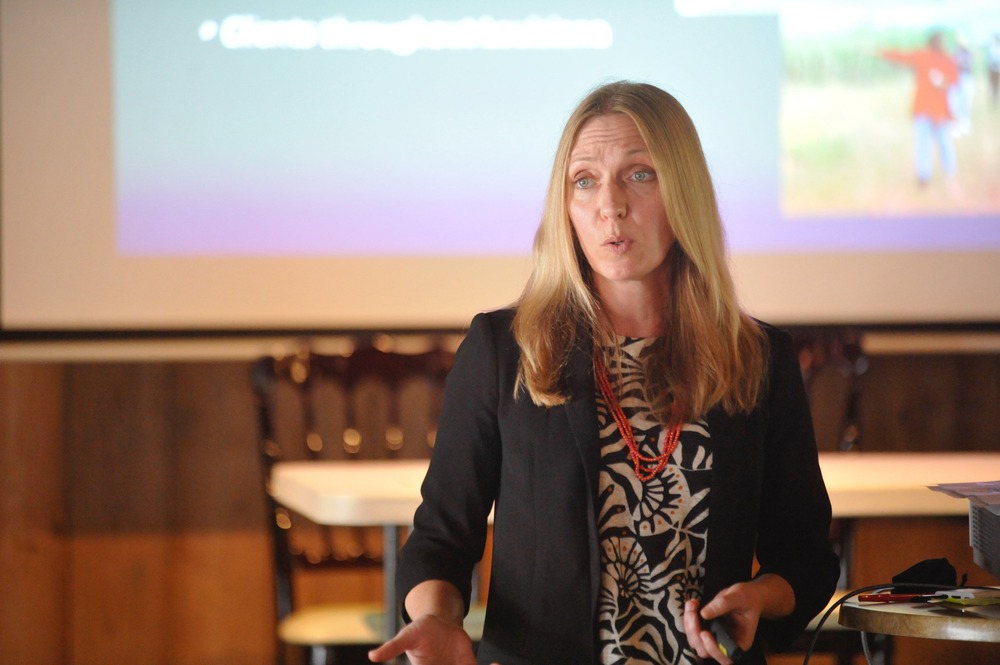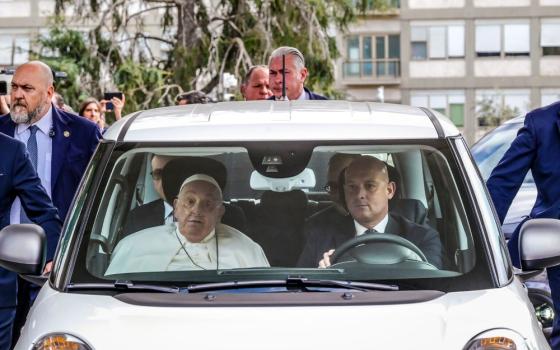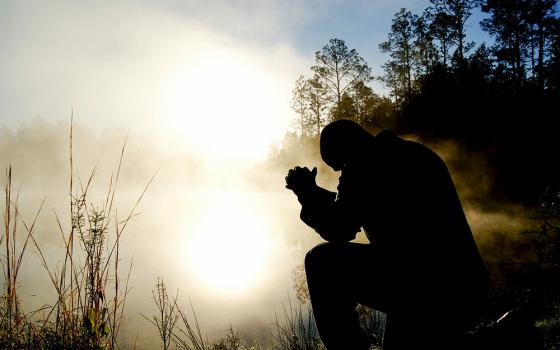
At a Catholic health conference April 4-5 in Vacherie, La., Kimberly Terrell, a research scientist and director of community engagement at the Tulane Environmental Law Clinic in New Orleans, said her recently released study indicates air pollution around Louisiana's petrochemical facilities has led to higher risks of low-birthweight and preterm babies in communities surrounding the plants. (OSV News/Clarion Herald, New Orleans/Peter Finney Jr.)
In an effort to blunt criticism of the poor air quality in Beijing prior to the 2008 Summer Olympics, the Chinese government implemented ambitious measures to curb air pollution.
The result was not exactly shocking to Kimberly Terrell, a research scientist and director of community engagement at the Tulane Environmental Law Clinic: Community and maternal health improved.
"We had kind of a natural experiment where, all of a sudden, you had this improvement in air quality," Terrell told a Catholic health conference at Oak Alley Plantation in Vacherie April 4-5, sponsored in part by the Archdiocese of New Orleans and the Diocese of Baton Rouge, on the effects of petrochemical pollution on the unborn and maternal health.
"Babies were born healthier because of that," Terrell said, citing the Chinese experiment. "A study came out several years ago that found that low birthweight was less of an issue during that period of improved air quality in Beijing."
The Catholic health conference, four years in the making, was cosponsored by the Catholic Climate Covenant, the Jesuits' USA Central and Southern Province, the Loyola Institute for Ministry and Rise St. James Louisiana, a community watchdog group that advocates for environmental justice in towns along the Mississippi River teeming with petrochemical facilities.
Baton Rouge Bishop Michael Duca, who attended the conference, said the premise that the byproducts of petrochemical facilities harm the health of those living nearby the plants needs to be addressed rationally by beginning a conversation among community members, corporations and scientists.
"It's important that we get the word out about all the many different challenges there are in dealing with people living close to petrochemical companies and try to begin a conversation somewhere — even getting people in the industry together to talk about this in a civil and reasonable way," Duca said. "We need to talk to the people who are sick, the families who are being affected, and try to come up with whatever the answer is. Even if (industry is) just part of the answer, we need to make sure they're not adding to the problem. There's a host of other reasons. It's a very complicated issue."
Terrell said the challenge faced by community groups in advocating for best steps to improve environmental safety is partly related to the lack of scientifically valid studies that have been conducted in Louisiana. While there are hundreds of studies "connecting pollution exposure with adverse birth outcomes" — especially in California and Texas — Louisiana has conducted only one such study.
"There's one, peer-reviewed study linking or even evaluating pollution relative to human birth outcomes," Terrell said. "This lack of research is being weaponized against communities like St. James and St. John (parishes) because we hear over and over, 'Hey, there's no evidence to support what the community is saying.' A lack of research always results in a lack of evidence."
She cited the 1980s mystery in St. Gabriel, Louisiana, when pharmacist Kay Gaudet began to detect a pattern of women coming in for medication after having suffered miscarriages. The high miscarriage rate eventually gained national attention because of the thesis that chemicals released into the air contributed to the problem.
"She started keeping track of miscarriages, and by the time she got to 60, she reached out to the media because she thought maybe this had something to do with all the heavy industry around her community," Terrell said. "Her 9-year-old daughter summed up this concern: 'Why are all these babies dying?'"
The reaction by the chemical industry to the media floodlight was predictable, Terrell said. The president of the Louisiana Chemical Association said: "They say the chemical plants are causing the miscarriages, but they have no proof. I could say that they (have sex) too much, and that's the cause of miscarriages."
Advertisement
Even when the state health department conducted a study of the St. Gabriel miscarriages, Terrell said the study was not designed to answer the question of whether or not environmental contaminants led to fetal loss.
Terrell said the St. Gabriel study analyzed fewer than 400 births, "which is not a lot for an epidemiological study."
"They would have needed to include almost 900 births to reliably detect an elevated rate," she said. "So, while the study concluded that miscarriage rates were not elevated, a more appropriate conclusion would have been that there wasn't an adequate sample size and there wasn't any statistical analysis, so they couldn't rule out the possibility that those miscarriage rates were high."
In 2024, a team of scientists led by Terrell released the first peer-reviewed research on how pollution exposure influences birth outcomes in Louisiana. Her study suggested that "toxic air pollution is a major driver of the exceptionally high rates of low birthweight and preterm births in Louisiana."
Miscarriages are difficult to track, Terrell said, because some are not reported. However, birthweight and gestational age are universally reported by medical facilities.
"Our findings also reveal that these health burdens are far more extreme in certain neighborhoods," Terrell said. "Some census tracts had low birthweight rates that were more than double the Louisiana average and more than triple the U.S. average. There was a 36% higher risk of low birthweight and a 25% higher risk of preterm birth in the most polluted neighborhoods."
That equates to more than 2,000 cases of low birthweight babies and 3,500 cases of preterm birth annually in Louisiana "associated with pollution exposure."
Dan Misleh, founder and executive director of the Washington, D.C.-based Catholic Climate Covenant, said he was surprised to hear about the dearth of chemical emission monitoring around petrochemical facilities.
"I don't know quite what to make of that, except there seems to be a lack of curiosity here in Louisiana," Misleh said. "It's important that we get this data out so that we can do a better job of protecting human health. I am surprised there isn't more monitoring. It's complicated, like everything else. I'm sure there's some cost to it."
Terrell said quite often she will hear lawmakers or industry leaders make the argument that more people in Louisiana die of drunk driving or cigarette smoking than air pollution.
"That may be true, but the research hasn't been done," she said. "Second, from a public health perspective, it doesn't make sense to focus on only one risk factor. If somebody said to you, 'Drinking and driving really kills the most people,' that would sound pretty hollow as a reason to ignore those other risks."
Tom Ryan, chaplain at Loyola University New Orleans and professor of theology and ministry at the Loyola Institute for Ministry, gave an overview on why Catholic social teaching compels the faith community to advocate for vulnerable people.
"Sometimes we look at issues through the lens of the economy and jobs, and those are good things," Ryan said. "But what about looking at issues through the lens of the most vulnerable, which is what Jesus did? What about looking through the lens of the goodness of all creation, which is what Genesis 1 is all about? Our faith calls us to act justly. Too often, Sunday is separate from Monday. How can Sunday affect how we live on Monday?"
Tom Costanza, executive director of the Louisiana Conference of Catholic Bishops, said the focus of the conference was not to cast blame but to find faith-filled solutions to environmental problems.
"We want to be very scientific and data-driven to see if the linkages are accurate, so this is the beginning of the conversation," Costanza said. "We don't want to have conjecture or anecdotal stories. We need to study the communities along this corridor and ask the questions. Pope Francis wants us to encounter each other in dialogue. We're trying to bring the industry and the community together to have these dialogues based on science. We need to begin the conversation."





